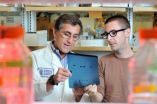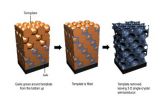(Press-News.org) CHESTNUT HILL, MA (July 22, 2011) – A designer metamaterial has shown it can engineer emitted "blackbody" radiation with an efficiency beyond the natural limits imposed by the material's temperature, a team of researchers led by Boston College physicist Willie Padilla report in the current edition of Physical Review Letters.
A "blackbody" object represents a theorized ideal of performance for a material that perfectly absorbs all radiation to strike it and also emits energy based on the material's temperature. According to this blackbody law, the energy absorbed is equal to the energy emitted in equilibrium.
The breakthrough reported by Padilla and colleagues from Duke University and SensorMetrix, Inc., could lead to innovative technologies used to cull energy from waste heat produced by numerous industrial processes. Furthermore, the man-made metamaterial offers the ability to control emissivity, which could further enhance energy conversion efficiency.
"For the first time, metamaterials are shown to be able to engineer blackbody radiation and that opens the door for a number of energy harvesting applications," said Padilla. "The energy a natural surface emits is based on its temperature and nothing more. You don't have a lot of choice. Metamaterials, on the other hand, allow you to tailor that radiation coming off in any desirable manner, so you have great control over the emitted energy."
Researchers have long sought to find the ideal "blackbody" material for use in solar or thermoelectric energy generation. So far, the hunt for such a class of thermal emitters has proved elusive. Certain rare earth oxides are in limited supply and expensive, in addition to being almost impossible to control. Photonic crystals proved to be inferior emitters that failed to yield significant efficiencies.
Constructed from artificial composites, metamaterials are designed to give them new properties that exceed the performance limits of their actual physical components and allow them to produce "tailored" responses to radiation. Metamaterials have exhibited effects such as a negative index of refraction and researchers have combined metamaterials with artificial optical devices to demonstrate the "invisibility cloak" effect, essentially directing light around a space and masking its existence.
Three years ago, the team developed a "perfect" metamaterial absorber capable of absorbing all of the light that strikes it thanks to its nano-scale geometric surface features. Knowing that, the researches sought to exploit Kirchoffs's law of thermal radiation, which holds that the ability of a material to emit radiation equals its ability to absorb radiation.
Working in the mid-infrared range, the thermal emitter achieved experimental emissivity of 98 percent. A dual-band emitter delivered emission peaks of 85 percent and 89 percent. The results confirmed achieving performance consistent with Kirchoff's law, the researchers report.
"We also show by performing both emissivity and absorptivity measurements that emissivity and absorptivity agree very well," said Padilla. "Even though the agreement is predicted by Kirchoff's law, this is the first time that Kirchoff's law has been demonstrated for metamaterials."
The researchers said altering the composition of the metamaterial can results in single-, dual-band and broadband metamaterials, which could allow greater control of emitted photons in order to improve energy conversion efficiency.
"Potential applications could lie in energy harvesting area such as using this metamaterial as the selective thermal emitter for thermophotovoltaic (TPV) cells," said Padilla. "Since this metamaterial has the ability to engineer the thermal radiation so that the emitted photons match the band gap of the semiconductor – part of the TPV cell – the converting efficiency could be greatly enhanced.
INFORMATION:
In addition to Padilla, the research team included BC graduate student Xianliang Liu, Duke University's Nan Marie Jokerst and Talmage Tyler and SensorMetrix, Inc., researchers Tatiana Starr and Anthony F. Starr.
Shining a light on the elusive 'blackbody' of energy research
Boston College researchers' designer material has potential applications for thermophotovoltaics
2011-07-25
ELSE PRESS RELEASES FROM THIS DATE:
Life scientists use novel technique to produce genetic map for African Americans
2011-07-25
UCLA life scientists and colleagues have produced one of the first high-resolution genetic maps for African American populations. A genetic map reveals the precise locations across the genome where DNA from a person's father and mother have been stitched together through a biological process called "recombination." This process results in new genetic combinations that are then passed on to the person's children.
The new map will help disease geneticists working to map genetic diseases in African Americans because it provides a more accurate understanding of recombination ...
Cellular stress can induce yeast to promote prion formation
2011-07-25
It's a chicken and egg question. Where do the infectious protein particles called prions come from? Essentially clumps of misfolded proteins, prions cause neurodegenerative disorders, such as mad cow/Creutzfeld-Jakob disease, in humans and animals. Prions trigger the misfolding and aggregation of their properly folded protein counterparts, but they usually need some kind of "seed" to get started.
Biochemists at Emory University School of Medicine have identified a yeast protein called Lsb2 that can promote spontaneous prion formation. This unstable, short-lived protein ...
NASA catches 3 tropical cyclones at 1 time
2011-07-25
It's not often that a satellite can capture an image of more than one tropical cyclone, but the GOES-13 satellite managed to get 3 tropical cyclones in two ocean basins in one image today. Bret and his "sister" Cindy are racing through the North Atlantic, while another area tries to develop far to their south. "Cousin" Dora is still a hurricane in the eastern Pacific.
In infrared image taken on July 22 at 0845 UTC (4:45 a.m. EDT), GOES-13 captured Tropical Depression Bret, Tropical Storm Cindy in the north Atlantic and low pressure area associated with a tropical wave ...
Northwest Forest Plan has unintended benefit – carbon sequestration
2011-07-25
CORVALLIS, Ore. – The Northwest Forest Plan enacted in 1993 was designed to conserve old-growth forests and protect species such as the northern spotted owl, but researchers conclude in a new study that it had another powerful and unintended consequence – increased carbon sequestration on public lands.
When forest harvest levels fell 82 percent on public forest lands in the years after passage of this act, they became a significant carbon "sink" for the first time in decades, absorbing much more carbon from the atmosphere than they released. At the same time, private ...
New target found for nitric oxide's attack on salmonella bacteria
2011-07-25
A new target for nitric oxide has been revealed in studies of how it inhibits the growth of Salmonella. This bacterium is a common cause of food-poisoning.
"Nitric oxide is naturally produced in the nose and the gut and other tissues in the body to ward off infection," explained the senior author of the paper, Dr. Ferric Fang. He is a University of Washington (UW) professor of laboratory medicine, microbiology and medicine.
Nitric oxide – not to be confused with nitrous oxide, the laughing gas in dentists' offices – is similar to the preservatives in hotdogs, Fang ...
2 genetic variations predict second cancers after radiation for children with Hodgkin lymphoma
2011-07-25
A genome-wide association study published in the August issue of Nature Medicine has found two tiny genetic variations that can predict which patients with Hodgkin's lymphoma are most likely to develop radiation-induced second cancers years after treatment. Knowing in advance who is at risk could help physicians tailor treatment to reduce the risks for patients who are most susceptible to long-term damage.
Hodgkin's lymphoma is one of the most treatable cancers, with more than 90 percent of patients surviving after a combination of radiation and chemotherapy. But nearly ...
Graphene's 'quantum leap' takes electronics a step closer
2011-07-25
Writing in the journal Nature Physics, the academics, who discovered the world's thinnest material at The University of Manchester in 2004, have revealed more about its electronic properties.
Research institutes and universities around the world are already looking at ways to build devices such as touch-screens, ultrafast transistors and photodetectors.
Now the research from the creators of the material promises to accelerate that research, and potentially open up countless more electronic opportunities.
The researchers, from the universities of Manchester, Madrid ...
Pocket chemistry: DNA helps glucose meters measure more than sugar
2011-07-25
CHAMPAIGN, Ill. — Glucose meters aren't just for diabetics anymore. Thanks to University of Illinois chemists, they can be used as simple, portable, inexpensive meters for a number of target molecules in blood, serum, water or food.
Chemistry professor Yi Lu and postdoctoral researcher Yu Xiang published their findings in the journal Nature Chemistry.
"The advantages of our method are high portability, low cost, wide availability and quantitative detection of a broad range of targets in medical diagnostics and environmental monitoring," Lu said. "Anyone could use it ...
New photonic crystals have both electronic and optical properties
2011-07-25
CHAMPAIGN, Ill. — In an advance that could open new avenues for solar cells, lasers, metamaterials and more, researchers at the University of Illinois have demonstrated the first optoelectronically active 3-D photonic crystal.
"We've discovered a way to change the three-dimensional structure of a well-established semiconductor material to enable new optical properties while maintaining its very attractive electrical properties," said Paul Braun, a professor of materials science and engineering and of chemistry who led the research effort.
The team published its advance ...
Epigenetic 'memory' key to nature versus nurture
2011-07-25
Researchers funded by the Biotechnology and Biological Sciences Research Council (BBSRC) at the John Innes Centre have made a discovery, reported this evening (24 July) in Nature, that explains how an organism can create a biological memory of some variable condition, such as quality of nutrition or temperature. The discovery explains the mechanism of this memory – a sort of biological switch – and how it can also be inherited by offspring.
The work was led by Professor Martin Howard and Professor Caroline Dean at the John Innes Centre, which receives strategic funding ...
LAST 30 PRESS RELEASES:
Researchers find promising new way to boost the immune response to cancer
Coffee as a staining agent substitute in electron microscopy
Revealing the diversity of olfactory receptors in hagfish and its implications for early vertebrate evolution
Development of an ultrasonic sensor capable of cuffless, non-invasive blood pressure measurement
Longer treatment with medications for opioid use disorder is associated with greater probability of survival
Strategy over morality can help conservation campaigns reduce ivory demand, research shows
Rising temperatures reshape microbial carbon cycling during animal carcass decomposition in water
Achieving ultra-low-power explosive jumps via locust bio-hybrid muscle actuators
Plant-derived phenolic acids revive the power of tetracycline against drug-resistant bacteria
Cooperation: A costly affair in bacterial social behaviour?
Viruses in wastewater: Silent drivers of pollution removal and antibiotic resistance
Sub-iethal water disinfection may accelerate the spread of antibiotic resistance
Three in four new Australian moms struggle with body image
Post-stroke injection protects the brain in preclinical study
Cardiovascular risk score predicts multiple eye diseases
Health: estimated one in ten British adults used or interested in GLP-1 medications for weight loss
Exercise to treat depression yields similar results to therapy
Whooping cough vaccination for pregnant women strengthens babies’ immune system
Dramatic decline in new cases of orphanhood in Uganda driven by HIV treatment and prevention programs
Stopping weight loss drugs linked to weight regain and reversal of heart health markers
Higher intake of food preservatives linked to increased cancer risk
Mass General Brigham–developed cholera vaccine completes phase 1 trial
First experimental validation of a “150-year-old chemical common sense” direct visualization of the molecular structural changes in the ultrafast anthracene [4+4] photocycloaddition reaction
Lack of support for people on weight loss drugs leaves them vulnerable to nutritional deficiencies, say experts
Dogs’ dinners can have greater climate impact than owners’
Are you ready to swap salmon for sprats and sardines?
1.6 million UK adults used weight loss drugs in past year
American College of Cardiology comments on new dietary guidelines for Americans
American Society of Gene & Cell Therapy and Orphan Therapeutics Accelerator partner to advance and commercialize promising rare disease treatments
One in 14 patients having day case surgery have new or worse chronic pain 3 months after their operation
[Press-News.org] Shining a light on the elusive 'blackbody' of energy researchBoston College researchers' designer material has potential applications for thermophotovoltaics





